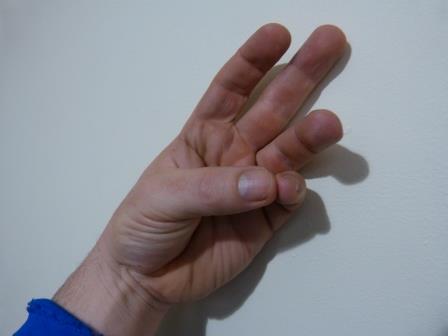By Sean Fagan

No matter how beautiful and serene a remote landscape is, there are always risks associated with wild places - such as hypothermia (Photo: Sean Fagan).
...
Learn a Simple Way to Prevent Hypothermia
.
Hypothermia is basically a cooling of the body to such an extent that the body cannot maintain its optimal core temperature of 36.5 - 37 degrees centigrade.
You might think that a drop in core temperature of only a few degrees might be of no consequences – that’s certainly not the case.
When the core temperature drops only a few degrees centigrade a cascade of potentially lethal symptoms can begin to manifest out of nowhere…
Shivering (sometimes violent), disorientation, clumsiness, slurred speech, a withdrawn attitude and a loss of manual dexterity are some of the more conspicuous symptoms of hypothermia.
As you can imagine, having some or all of the above symptoms can be a disastrous impediment for an outdoors person.
THE IMPORTANCE OF THE HANDS WHEN OUTDOORS
.
The ability to use your hands at all times, when outdoors, is a crucial asset.
Basically our hands can get us out of trouble. This is especially true when it comes to hypothermia.
A loss of manual dexterity brought about by hypothermia brings about a corresponding inability to do simple but vital tasks such as igniting a fire or opening a cabin door to get out of the elements. We can even lose the ability to remove damp clothing from our own bodies.
Hypothermia is that serious, that incapacitating.
Essentially, a lone hypothermic person with a serious loss of manual dexterity has more or less lost the ability to reverse the dangerous symptoms of hypothermia from escalating.
.
THE HYPOTHERMIC INCAPACITY TEST
.
A really quick way to test for a loss of manual dexterity is to try to touch your thumb to your small finger.
.

The Hypothermic Incapacity Test. A quick, convenient way to ensure your manual dexterity is good enough to get you out of trouble (photo: Sean Fagan).
.
If an individual cannot touch their thumb to their little finger, immediate action should be taken to warm herself or himself (such as mild exercise to restore functional manual dexterity).
I would go even further. If it requires considerable effort to touch the thumb to the small finger then it’s time to seek ways to warm up. Just because someone can touch the thumb to the little finger doesn’t mean that person is out of the woods, so to speak.
Any significant stiffness in the hands during cold or/and wet conditions should be seen as a possible sign of trouble ahead as regards hypothermia.
And that can mean making sure your hands stay reasonably warm, dry and dextrous at all times, or at least most of the time - especially in cold and/or damp climates.
Using (when appropriate) a simple, preventative measure against the possible occurrence of hypothermia, such as the hypothermic incapacity test, will enable you to know if you are fully functional and able to look after yourself.
What I like about this simple test is its easy to remember and apply with results that are immediately conclusive.
Of course, any seasoned outdoors person worth his or her salt has experienced occasional stiffness of the hands during cold/wet conditions. When to pay heed to the hypothermic incapacity test is very context specific. A little stiffness in the hands while chopping wood near a stove-heated cabin is not nearly as urgent as stiff hands while hiking up a desolate mountain with a blizzard shifting in, with a couple of hours of hiking left before a shelter can be reached.
.
A CAUTIOUS ATTITUDE WINS
What I'm trying to strongly convey in this article is very simple: the hands are crucial outdoor assets!
Building up a more consistent awareness of the hands, so the outdoor enthusiasts can become more attuned to the health of the hands, is a good thing.
.
In summary, cold and/or wet weather should be treated with respect.
As a seasoned outdoors person once quipped “you can’t beat nature”.
After all, it’s generally a much better idea to work with, rather than against, her grand plans.
.
WARNING: This article is not a comprehensive definition of the signs, symptoms & treatment of hypothermia.
*DO NOT NECESSARILY DEPEND SOLELY ON THE HYPOTHERMIC INCAPACITY TEST TO DETERMINE IF HYPOTHERMIA IS OCCURRING (Ideally, use it in conjunction with other symptoms of hypothermia).
To learn more about the symptoms of hypothermia, click here.
.
.
Related articles on this website:- Learn 4 Wilderness Safety Tips
- "The woods are lovely, dark & deep" (Why the Northern Woods are Great)
- The Allure of the Winter Sky
.
*Check us out on Instagram, Twitter & Facebook for more outdoor-related topics..
.PIONEER BUSHCRAFT DISCLAIMER
.
The aim of this article is to provide advice that will enhance the quality of your time, and well-being, when outdoors.
Pioneer Bushcraft does not take any responsibility for the misapplication of advice in this article.
The advice in this article is very much an adjunct to, and not a substitute for, high-quality bushcraft training (including outdoor medical training), relevant research and experience, trustworthy local knowledge, a thorough risk assessments and all other health & safety considerations specific and pertinent to your outdoor excursions.
When outdoors, take responsibility for your well being seriously.
It can make all the difference between a great or bad outdoor experience.

Recent Comments